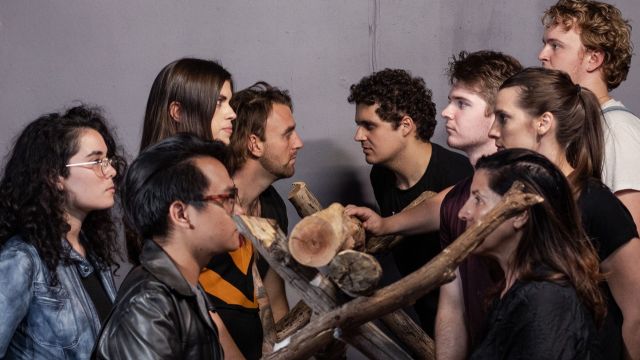The Laramie Project
If I was a casting director, I would head over to Ad Astra’s production of The Laramie Project right now to check out a wonderful showcase of talented performers. Nine actors play more than 60 characters in a great example of ‘verbatim’ theatre, based on court transcripts and interviews with residents of Laramie, Wyoming in the wake of Matthew Shepard’s murder in the cold October of 1998. Laramie is almost dead centre of the map of North America: West to East, the mid-point along highway 80 between Chicago and San Francisco; and North to South, the halfway mark en route from New Mexico to Canada. Despite its Wild West mythology (home to Butch Cassidy and the Sundance Kid), it appears to have developed into a liberal and educated population, dubbed the Equality State for being the first to let women vote. It is also a university town with a large gay population. That welcoming reputation changed the night that openly gay 21-year-old student, Matthew Shepard, was brutally beaten by two young men and left for dead on the Laramie plains. In the two years that followed, Moises Kaufmann and members of his New-York-based Tectonic Theatre Project took six trips to Laramie and interviewed townsfolk to start the research that shapes The Laramie Project.
Director Michelle Carey places her talented mostly Brisbane-based cast in a simple set – the scene of the crime an ever-present wooden fence that dominates the small space. The Ad Astra studio is one where you are close to the action, especially in this script where each character speaks directly to the audience. Fortunately, there is some humour and song to break up the sadness. It feels wrong to be innervated by performances in a piece with such a tragedy at its centre. But it takes heart and soul to present this story and that certainly stands out with Carey’s casting choices. It is impossible to single out any one of this excellent cast who work as a true ensemble, supporting one another with the difficult material. This is not the place for upstaging your colleagues, and there is a real respect in the performances. Tomer Dimanstein, Andrew Fraser, Eleonora Ginardi, Elyse Johnston, Chris Nguyen, Kirsty Pickering, Chad Terry, Charlotte Trevaskes, and Sam Webb play regular townspeople, Matthew’s fellow students, teachers, priests, police officers, news reporters, and finally the accused, as well as the victim’s parents. It is very emotional and confronting material, but despite the starkness, the play is full of hope – there are gospel and folk songs, friendships, love and people power. Some townspeople who started in prejudice ended in a place of compassion. Minds were changed. The actors each tackle several characters with a mixture of accents and simple costume changes to differentiate each one. A backdrop screen projection captions each person in turn, but the performers make it easy to identify who is the focus at any time. (But a big hand to Stage Manager, Tamika Lea for no distracting slip-ups). Carey’s direction focuses on the humanity of each character; she avoids the temptation to caricature or fall into stereotypes of ‘good’ and ‘evil’, and her choice to allow some natural voices among the American accents works because it lets each character express their own version of the truth. While the play’s message may be preaching to the converted in the audience it attracts, it is always worth reminding ourselves that hate can take hold anywhere. As Carey points out, gay hate crime is not confined to middle America: where crimes occur, there are ordinary folk, some perpetrators and some who merely stand by and let them happen. And, even after Matthew Shepard’s murder, it took more than 10 years for national legislation to be introduced in the US. And as for the state of Wyoming? It is yet to pass any law that specifically deals with hate crime.
Beth Keehn
Photographer: Theo Bourgoin
Subscribe to our E-Newsletter, buy our latest print edition or find a Performing Arts book at Book Nook.

